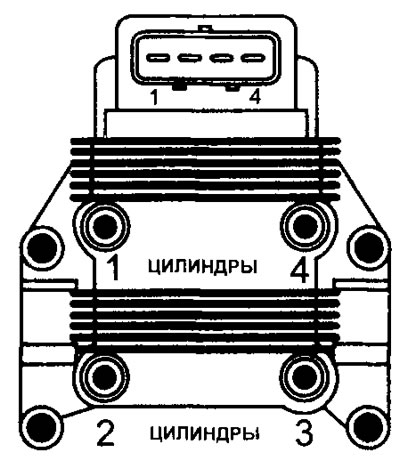
11.16 Static ignition coil (DIS)
Therefore, two pairs of ignition coils are required for a 4-cylinder engine. Approximately 3 kV is still needed to create «idle spark». Each ignition coil receives voltage from the ignition switch. In addition, separate connectors for each ignition coil are made between the electronic control unit and the amplifier. The electronic control unit and amplifier consists of two separate circuits, so that each ignition coil can be switched on individually and in turn.
Ignition coils use low resistance on the primary side of the ignition coil to increase primary current and primary energy. The amplifier limits the current in the primary winding to approximately 8 A in order to accumulate the necessary energy reserve to create a spark discharge.
Setting the ignition timing
The ignition timing setting is not adjustable on models equipped with Bosch Motronic MP3.2.
Voltage values in the primary winding of the ignition coil
Terminal numbers
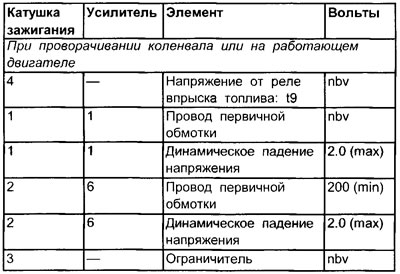
See illustration 11.10
Resistance values on the primary winding of the ignition coil
Terminal numbers
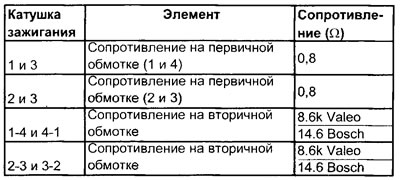
Ignition Coil Primary Duty Cycle Table
| RPM | duty cycle % | msec (ms) |
| When turning the crankshaft | 15-30 | 15.0-20.0 |
| 1000 | 5-20 | 5.0 - 6.0 |
| 2000 | 25-35 | 5.0-6.0 |
| 3000 | 30-40 | 5.0-6.0 |
Checking the primary winding of the ignition coil (general check)
1. Check up reliability of connection of plugs of the coil of ignition.
2. Clean accumulated dirt and deposits from the DIS ignition coil pack using an aerosol. The remaining dirt contributes to the formation of new dirt, which often leads to leakage currents.
3. Inspect ignition coil for excessive leaks (current), especially around the spool pin.
4. Connect the negative lead of an oscilloscope or breaker closed time meter to ground on the motor.
5. Connect the positive lead of an oscilloscope or breaker closed time meter to the negative terminal (-) one of the two ignition coils #1 or #2.
6. Bosch Motronic MP3.2 ignition system (DIS) can be divided into two separate circuits. Each individual circuit includes two ignition coils (to create a spark discharge on two spark plugs), the output signal of the amplifier and the control signal from the electronic unit to the amplifier. Each circuit must be checked individually.
7. After checking one ignition coil and its connections to the amplifier and the electronic control unit, repeat the check of the other ignition coil circuit.
Checks with the engine off
1. Ignition coil #1 connects to cylinders #1 and #4.
2. Ignition coil #2 is connected to cylinders #2 and #3.
3. Connect an oscilloscope or breaker open time meter to terminal #1 of the ignition coil (ignition coil #1).
4. Turn the crankshaft and record the results (see illustration 11.17).
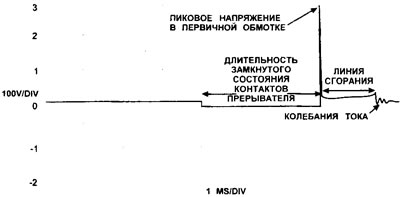
11.17 Typical primary signal from ignition amplifier
5. Connect an oscilloscope or breaker open time meter to terminal #2 of the ignition coil (ignition coil no. 2).
6. Turn the crankshaft and record the results (see illustration 11.17).
7. Either the primary waveform or duty cycle reading must be obtained on both circuits. If the device can measure readings in milliseconds, then this is the most successful measurement.
Oscilloscope
In addition to a clear waveform, peak voltages in the primary must be at least 300 volts.
Analysis
1. Clear primary waveform or sufficient signal on both ignition coils:
- Primary winding of the ignition coil (including crank angle sensor (CAS)) gives a sufficient signal.
- The fault is not related to the low voltage circuit of the ignition system.
- Fuzzy primary waveform or weak signal on both coils
- Ignition
1. Weak signal on both ignition coils: Check the crank angle sensor signal supply to the electronic control unit.
2. Continue the following checks on both ignition coils.
Fuzzy primary waveform or weak signal at ignition coil #1
1. Connect an oscilloscope or voltmeter to the positive terminal (+) ignition coils number 3.
2. Turn the crankshaft or shunt the relay.
3. Check the rated voltage of the battery. This voltage comes from the fuel injection relay (F1) when turning the crankshaft or while the engine is running.
4. Shunt the relay and check the voltage supply to the negative terminal (-) Ignition Coil No. 1. Terminal No. 1 of the ignition coil is connected to terminal No. 1 of the amplifier.
5. If there is no voltage, disconnect the wire from the negative terminal (-) ignition coils and check again.
6. If there is still no voltage, check the resistance on the primary side of ignition coil #1.
7. The voltage corresponds to the rated voltage of the battery, check for a short to «mass» between terminal No. 1 of the ignition coil and terminal No. 1 of the amplifier.
Fuzzy primary waveform or weak signal at ignition coil #2
1. Connect an oscilloscope or voltmeter to the positive terminal (+) ignition coils number 3.
2. Turn the crankshaft or shunt the relay.
3. Check the rated voltage of the battery. This voltage comes from the fuel injection relay (FI) when turning the crankshaft or while the engine is running.
4. Shunt the relay and check the voltage supply to the negative terminal (-) Ignition Coil No. 2. Terminal No. 2 of the ignition coil is connected to terminal No. 6 of the amplifier.
5. If there is no voltage, disconnect the wire from the negative terminal (-) ignition coils and check again.
6. If there is still no voltage, check the resistance on the primary winding of ignition coil #2.
7. Voltage at the nominal voltage of the battery, check for a short to «mass» between terminal No. 2 of the ignition coil and terminal No. 6 of the amplifier.
Control signal checks
1. Bend the insulation to the ignition amplifier and connect the positive probe of the oscilloscope or the meter of the duration of the closed state of the breaker contacts to terminal No. 2.
Note. When output block is available (WWII) Tests can be performed by connecting the output unit to the ECU pins.
2. Turn the crankshaft. The instrument will display the control signal as a square wave (see illustration 11.18) or duty cycle indication.
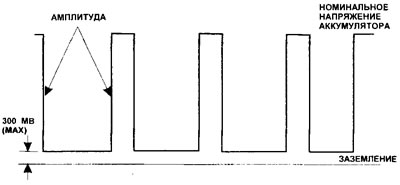
11.18 Typical signal of the primary winding of the ignition coil from the electronic control unit to the ignition amplifier
3. Connect the positive probe of an oscilloscope or a meter for the duration of the closed state of the breaker contacts to terminal No. 7.
4. Rotate the crankshaft. The instrument will display the control signal as a square wave or duty cycle indication.
5. If no signal is being received at one or the other terminal of the amplifier, perform the following checks.
6. Turn off the ignition and disconnect the multi-pin connector of the electronic control unit and amplifier.
7. Check for continuity between ECM pin #1 and amplifier terminal #2.
8. Check for continuity between ECU pin #20 and amplifier terminal #7.
9. Check amplifier terminal #4 ground.
No waveform or duty cycle display on one or both circuits
1. Check the continuity of the wires between the corresponding terminal of the amplifier and the contact pin of the electronic control unit.
2. If the condition of the wires is normal, then check the voltage supply to the electronic control unit and its grounding. If the voltage supply and grounding are in order, then the electronic control unit may be faulty. However, before replacing the electronic control unit, the ignition coil to be replaced should be checked.
3. The control signal is normal, but the absence of output voltage from the amplifier suggests its malfunction.
4. Checks with the engine running.
5. Connect an oscilloscope or breaker closed time meter to the negative terminal of ignition coil #1.
6. Start the engine at idle and let it run at various speeds. Record duty cycle, maximum primary voltage level, and dynamic voltage drop.
7. Compare the values with the values given in the specifications.
8. Connect an oscilloscope or breaker closed time meter to the negative terminal of ignition coil #2.
9. Repeat the above checks and record the values obtained.
10. Compare the values with the values given in the specifications and with the oscilloscope values obtained by connecting it to the negative terminal of ignition coil #1.
11. If the values do not correspond to the nominal values, then check the resistance on the primary winding of ignition coils No. 1 and No. 2. Different resistance values are caused by different duty cycle values. If the resistances on the primary winding of the ignition coil are similar, then the ignition amplifier control unit may be faulty.
Note. Duty cycle readings are different between different vehicles of the same model. However, ms readings should be as accurate as possible.
12. It is important that as the engine speed increases, the duty cycle percentages (%) for each ignition coil increased.
13. It is important that as the engine speed increases, the duty cycle in ms does not vary too much for each ignition coil.
14. If the dynamic voltage drop is high (typically over 2.5 volts) coupled with low peak voltage in the primary winding and high pulse expansion % (idle), then you should check the performance of the amplifier.
Warning. If the dynamic voltage drop is high (typically over 2.5 volts), but the peak value of the voltage in the primary winding and the expansion of the pulses% is normal, then the amplifier may be working.
Warning. The reading will not improve when the amplifier is replaced just because the dynamic voltage drop is too high.
Amplifier Status Checks
1. Check amplifier grounding.
2. Make sure that wires from devices such as radio interference suppressors or intruder alarm systems are not connected to the terminal (-) primary winding of the ignition coil.
3. If the ground and wires are normal, and the peak value of the primary voltage and the expansion of the pulses % in idle mode is very high, then the amplifier is definitely defective. Read the warning above before replacing the amplifier.
